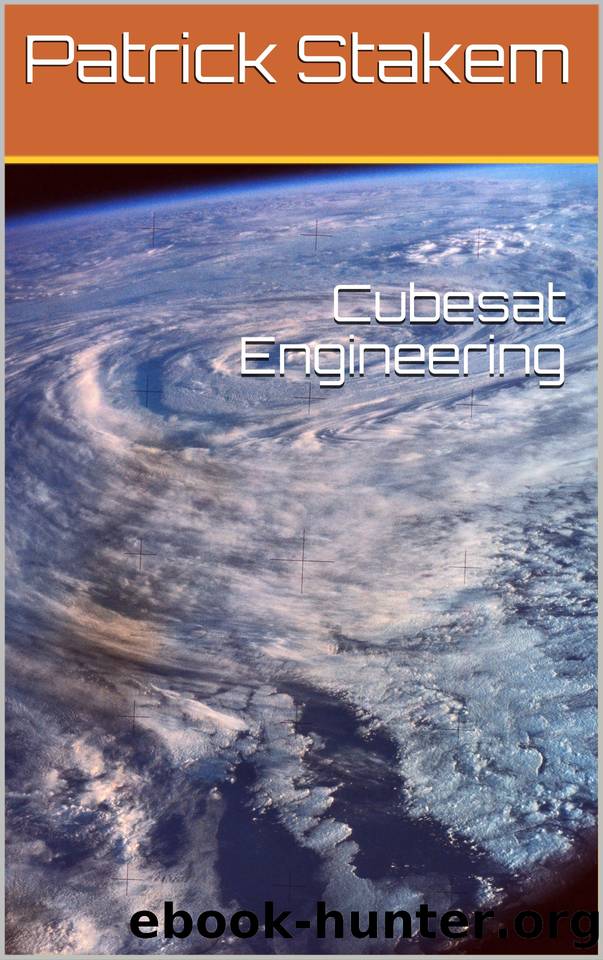Cubesat Engineering (Space Book 1) by Stakem Patrick

Author:Stakem, Patrick [Stakem, Patrick]
Language: eng
Format: epub
Published: 2017-02-01T16:00:00+00:00
Thermal engineer.
Electrical systems engineer. (hardware).
Onboard data system (software).
RF Engineer, CMD/TLM – also certified as amateur radio operator, responsible for license adherence.
Planning and scheduling.
IT security.
In a small mission, some personnel can provide multiple roles. In really small missions, it could just be you.
Mission Planning and scheduling
The Planning and Scheduling function does not need to be real time, but should always be ahead of wall-clock time. It will result in a detailed, optimized schedule of operations, for a 24-hour period or longer. It may involve complex predictive modeling of the spacecraft and its environment. Once the time-line is verified, it will be mapped into commands and sent to the spacecraft for execution. There are also contingencies for special conditions and anomalies. These are done ahead of when they are needed.
Some items that might have to be factored into the time-line include entrance and exit from the South Atlantic Anomaly (SAA) radiation zone, which might require turning off certain sensitive equipment. There is also the issue of Earth occultation (when the spacecraft is on the opposite side of the Earth from the Sun, and thus has no solar power), and possibly a lunar eclipse, which will also block the Sun.
If we are relying on sensing the Earth's rim to keep pointing to a desired terrestrial target, we must also know when the Sun will blind the horizon sensor. It is also possible that the moon will be partially obscured by the Earth from the spacecraft's point of view, and a horizon sensor would see that as a “bigger” Earth. We need to know when the spacecraft is in line-of-sight with a ground station and when it has no-communication “dark zones.”
Engineering support, or housekeeping activities, are accomplished according to schedule, or in response to conditions. An example is momentum unloading. To keep properly oriented, the spacecraft may use momentum wheels. These are spun at high speed to move the much more massive spacecraft in the opposite rotation, slowly. The problem is, there are biases in the gravity field that cause the momentum wheels to become saturated at some point, days, usually. How can we get rid of this momentum, there's nothing to push against? Actually, there is. We can push against the Earth's magnetic field. That requires a map of the field, from the spacecraft's point of view. Momentum wheel unloading can be adjusted accordingly.
Another commodity that has to be tracked is the amount of onboard storage for data. This might fill up, and need to be “dumped” to the ground when a communication channel is available. The spacecraft will need to point its solar arrays for getting the maximum power, its communication antenna to get the best signal, and perhaps movable parts of the science payload.
Onboard status monitoring is common today, but should still be backed up with ground-based monitoring and trending. It is usual to have spare components (4 momentum wheels when we only need three; redundant radios, etc). Spares management and planning for “Plan B”is critical when configuration changes are needed due to degradations and failures.
Download
This site does not store any files on its server. We only index and link to content provided by other sites. Please contact the content providers to delete copyright contents if any and email us, we'll remove relevant links or contents immediately.
| Automotive | Engineering |
| Transportation |
Whiskies Galore by Ian Buxton(41528)
Introduction to Aircraft Design (Cambridge Aerospace Series) by John P. Fielding(32888)
Small Unmanned Fixed-wing Aircraft Design by Andrew J. Keane Andras Sobester James P. Scanlan & András Sóbester & James P. Scanlan(32573)
Craft Beer for the Homebrewer by Michael Agnew(17932)
Turbulence by E. J. Noyes(7700)
The Complete Stick Figure Physics Tutorials by Allen Sarah(7137)
Kaplan MCAT General Chemistry Review by Kaplan(6595)
The Thirst by Nesbo Jo(6435)
Bad Blood by John Carreyrou(6274)
Modelling of Convective Heat and Mass Transfer in Rotating Flows by Igor V. Shevchuk(6222)
Learning SQL by Alan Beaulieu(6035)
Weapons of Math Destruction by Cathy O'Neil(5827)
Man-made Catastrophes and Risk Information Concealment by Dmitry Chernov & Didier Sornette(5645)
Digital Minimalism by Cal Newport;(5389)
Life 3.0: Being Human in the Age of Artificial Intelligence by Tegmark Max(5184)
iGen by Jean M. Twenge(5161)
Secrets of Antigravity Propulsion: Tesla, UFOs, and Classified Aerospace Technology by Ph.D. Paul A. Laviolette(4988)
Design of Trajectory Optimization Approach for Space Maneuver Vehicle Skip Entry Problems by Runqi Chai & Al Savvaris & Antonios Tsourdos & Senchun Chai(4839)
Electronic Devices & Circuits by Jacob Millman & Christos C. Halkias(4746)
